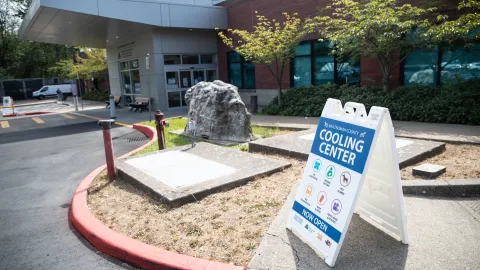Each summer health officials urge people to seek out cool spaces to beat the heat. Most days people can find relief at an area library, pool, mall, movie theater or museum. They can rest under a shady tree or nap at home in the comfort of air conditioning.

But there are times when high temperatures are forecast for a string of days with little overnight relief, when Multnomah County, in partnership with the City of Portland and other government agencies and community organizations, stand up formal locations for people to get relief.
In a more mild event, the County and its partners might open cooling centers at a few locations to help people through the hottest part of the day. During severe events like the heat dome of 2021, the County and partners open 24-hour cooling shelters.
The County’s approach tracks with the National Weather Service heat risk index, in which yellow equates to a low risk for people who are heat sensitive and those without effective cooling. The next stage is Orange, or moderate risk for people who are heat sensitive and those without effective cooling. Areas mapped in Red equate to a high risk for much of the population, especially those who are heat sensitive and those without effective cooling
Communications and outreach intensify with each level, and formal cooling centers or shelters are a consideration when the map shows our area may be at high risk, Red. The County considers several factors when determining when to open formal cooling centers or shelters:
- Daytime maximum temperatures and the duration of those highs.
- Nighttime minimum temperatures for a duration that allows people to recover and homes to air out.
- Time of year. Early season events are more severe because our bodies have not yet acclimated to the heat.
- Overlapping hazards. If more than one hazard is present it may dictate a more robust response.
The following thresholds, and our approach to severe heat, continues to evolve as we learn from partners and past events.
Threshold 1
- First 90 degree day of the summer
- Multnomah County and its partners hold a situational awareness conference call to discuss logistics, plans and communication.
Threshold 2
- The National Weather Service issues a Heat Advisory, Heat Watch, Heat Warning, or sends a Weather Briefing
- Multnomah County shifts to enhanced operations, and additional communications are planned and pushed out.
Threshold 3
- The Heat Risk Tool forecasts areas of our County at high risk, Red
- County offices and leadership hold coordination calls and may consider activating cooling centers or shelters.
Threshold 4
- The Heat Risk Tool forecasts areas of our County at extreme risk, Magenta
- County offices and leadership hold coordination calls and will activate cooling shelters.
